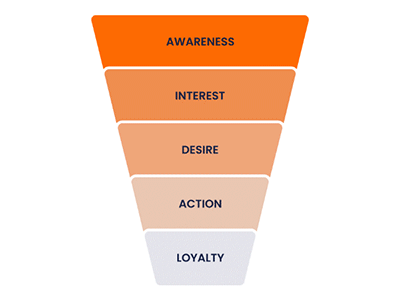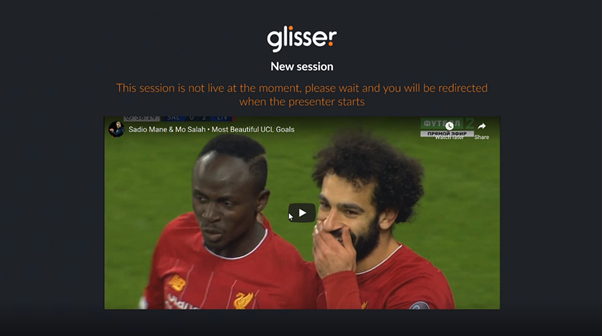“Where do virtual events sit within the marketing funnel?” is one of those fundamental questions that B2B marketing directors should be asking their teams. They leaped into our consciousness at the start of the pandemic, and we just, kind of, got on with them, but did we stop to ask what role they were serving? A stop gap for in-person events we could no longer run, or something else?
The typical B2B funnel takes your prospects on a journey down through an inverted triangle, from generating ‘Awareness’ at the very top before driving ‘Interest’ and ‘Desire’. (I appreciate we can redraw the funnel as a virtuous circle, refine the stages and use many other models, but let’s keep it simple).
On reaching the conversion stage, you’re looking to drive ‘Action’ and then ‘Loyalty’, so that those leads who have become valued customers feel rewarded and motivated to offer you their repeat business by re-entering the funnel at different points.
Many event types have tended to be placed into the ‘Awareness’ segment, including exhibitions, sponsorship and various PR-related activity. We’ve all manned booths at conferences where the sales team have told us that “we just need to be there, because our competitors are, and make sure we have the biggest stand”.
Webinars have traditionally helped businesses to drive ‘Interest’ as they’ve tended to drill down on a specific topic area, and pre-COVID webinar attendance tended to be confined to those fairly early in their search, enjoying the anonymity while gathering information. In the physical events space, knowledge sharing talks at vertically focused conferences have often served the same purpose.
Physical events offering pre-arranged meetings or product demonstrations with qualified buyers can help fuel ‘Desire’; and in-person events that bring existing customers together for reward and recognition have long been used to build ‘Loyalty’.
-width-1200-name-2022 Webinars LinkedIn 1200x627 (15).png.png) Just as with in-person events, marketing teams don’t need to pigeon-hole virtual meetings into one part of the funnel. The last two years have shown us that live online meetings can add value to all stages, and webinars, virtual events, or whatever we choose to call them, must no longer be confined to the ‘Interest’ step. And so we must design different online experiences specifically to cater for each segment.
Just as with in-person events, marketing teams don’t need to pigeon-hole virtual meetings into one part of the funnel. The last two years have shown us that live online meetings can add value to all stages, and webinars, virtual events, or whatever we choose to call them, must no longer be confined to the ‘Interest’ step. And so we must design different online experiences specifically to cater for each segment.
If we start with the ‘Awareness’ segment of the funnel, virtual events can be a great way to engage a wide and varied pool of stakeholders in a broad range of relevant topic areas.
One of the biggest advantages of using virtual meetings to drive awareness is that you can react quickly to trending topics, align with industry campaigns and launch activity much faster than organising a physical event. Turning a virtual event around within a week (including landing a speaker, inviting and registering an audience, and delivering the content) is absolutely doable. What’s more, the workload is relatively straightforward. This potential for a very high cadence of activity quickly builds a library of broadcast-quality relevant content that can be repurposed as blogs or social content, or re-used and made available on-demand.
If you’re designing virtual events to create awareness in your brand or product, it’s absolutely fine to focus on thought leadership around industry issues or bring-in third-party experts to discuss matters of interest to a much wider audience. In fact, it’s a great technique. This keeps your content fresh, and simplifies the creation process even more.
After all, you are simply trying to attract eyeballs at this stage, make more people aware of who you are, and position your brand as an authoritative voice within your sector.

View this infographic for more details.
As you head into the ‘Interest’ segment of the funnel, virtual event content should begin to focus on product-relevant topics such as solving customer pain-points and actual customer requirements.
Develop a more authoritative tone-of-voice and use in-house experts but keep it friendly and don’t let the event come across as a sales pitch.
Make sure that the experts you put in-front of the camera are either trained in online presenting, or that the event format is designed in such a way to allow them to shine. For example, a more technically-minded speaker may feel more comfortable answering questions rather than presenting information. In this instance you’d design the virtual event as an interview with extended Q&A perhaps, rather than a stream of PowerPoint slides.
Lead tracking and data gathering is also vital to the ‘interest’ stage. Use voting polls, engagement analytics and other touchpoint measurements to see who is interacting with the event, showing genuine interest and ripe for follow-up.
Moreover, look to team-up with complementary partners so that you can combine databases and reach new, relevant audiences. This is important to ensure your virtual events channel is genuinely scalable, rather than just a means of reaching your existing database.
For qualified audiences who are in active buying mode, you need to create ‘Desire’ and convert them through ‘Action’.
In my opinion, the best way to do this via virtual events is to invite actual customers to speak about a relevant topic area so that they subsequently validate your brand and subtly endorse your products.
As this stage is focused on Ideal Customer Profiles (ICPs) and qualified buyers, don’t fall into the trap of measuring audience size. It’s the quality and not the quantity of viewers that’s important here.
If you’ve got a small group of highly targeted and interested prospects, consider switching up the event format from a broadcast feed to an interactive web-conference, where viewers have their cameras and mics turned on and can ask your in-house experts direct questions and discuss their requirements.
Once you’ve converted your prospects into customers, use virtual events to build community by offering them exclusive content, product updates, the opportunity to provide transparent feedback, a fun, consistent and interactive way to keep them engaged, plus an effective means by which to drive loyalty and Net Promoter Scores (NPS).
In summary, ensure that you do three things:
- Match the design of your virtual events to the relevant funnel stage of your audience;
- Use interactivity to drive both engagement and data, and;
- Build an asset bank of content on a wide range of topics that’s ready to repurpose.
At Glisser, using virtual events as a marketing channel provides a seven times return on our investment, while our cost per SQO (Sales Qualified Opportunity) when using virtual events is significantly lower than all the other forms of marketing we use - email, digital, SDRs and physical events.
True - we don’t have to pay to use our own platform! But even if you’re paying a licence fee for Glisser (or our competitors - other platforms are available :-), the costs involved in running virtual events are extremely low, especially if you select a platform that is a single annual fee for unlimited audience numbers. This is even more important as marketing budgets come under scrutiny again and you need to sweat the assets you’ve invested in.
Pandemic or no-pandemic, they really are an exceptional channel for every B2B marketer. The wheels set in motion by COVID pushing us online for live meetings opened Pandora’s Box - most importantly to audiences who want to attend virtually - and it’s smart B2B marketers who benefit.
View this infographic for more information.
To watch Mike Piddock’s full presentation from B2B Ignite London 2022, entitled: Virtual virtuosity How to hone your virtual events for great CX and a full funnel, watch the video on YouTube here.
Book a Glisser platform demo at www.glisser.com/discover.





.png)
.png)
.png)